Over the past year, I had the opportunity to research, plan, and develop an exhibition at the Robert Rauschenberg Foundation with my Hunter College colleagues, Daniela Mayer, Lucy Riley, Joseph Shaikewitz, and Melissa Waldvogel, under the guidance of our distinguished professor, art historian and curator Emily Braun.
The exhibition, which opened on March 14 and will close on July 19, is the first to exclusively focus on Rauschenberg’s Night Shades and Phantoms, two distinct but related series of “metal paintings” from 1991. Produced on brushed and mirrored aluminum panels, these silkscreens are composed exclusively of the artist’s own photographs, which were captured on travels at home and abroad from 1979-1991. Rauschenberg’s photographs replaced those he previously appropriated from mass media print sources, shifting the frame of reference in his paintings from the public realm of current events and popular culture to one more defined by the artist’s personal experiences.
The Night Shades are distinguished by Rauschenberg’s application of Aluma Black, an oxidizing agent that immediately tarnished the aluminum surface, revealing and concealing the artist’s matter-of-fact images. In the spectral Phantoms, the faint screens compete with the transient reflections that enter the frame, which inherently include the viewer. Produced on the heels of three separate retrospective exhibitions, these ethereal works allude to Rauschenberg’s artistic past and, by conjuring the foggy realm of memory, address the difficulties of looking back.
My essay “Photosensitive Rauschenberg,” which examines the centrality of photography to these works and much of the artist’s creative output, will be included in the forthcoming exhibition catalogue.
Update: The Rauschenberg Foundation has made a digital version of the catalogue available here.

